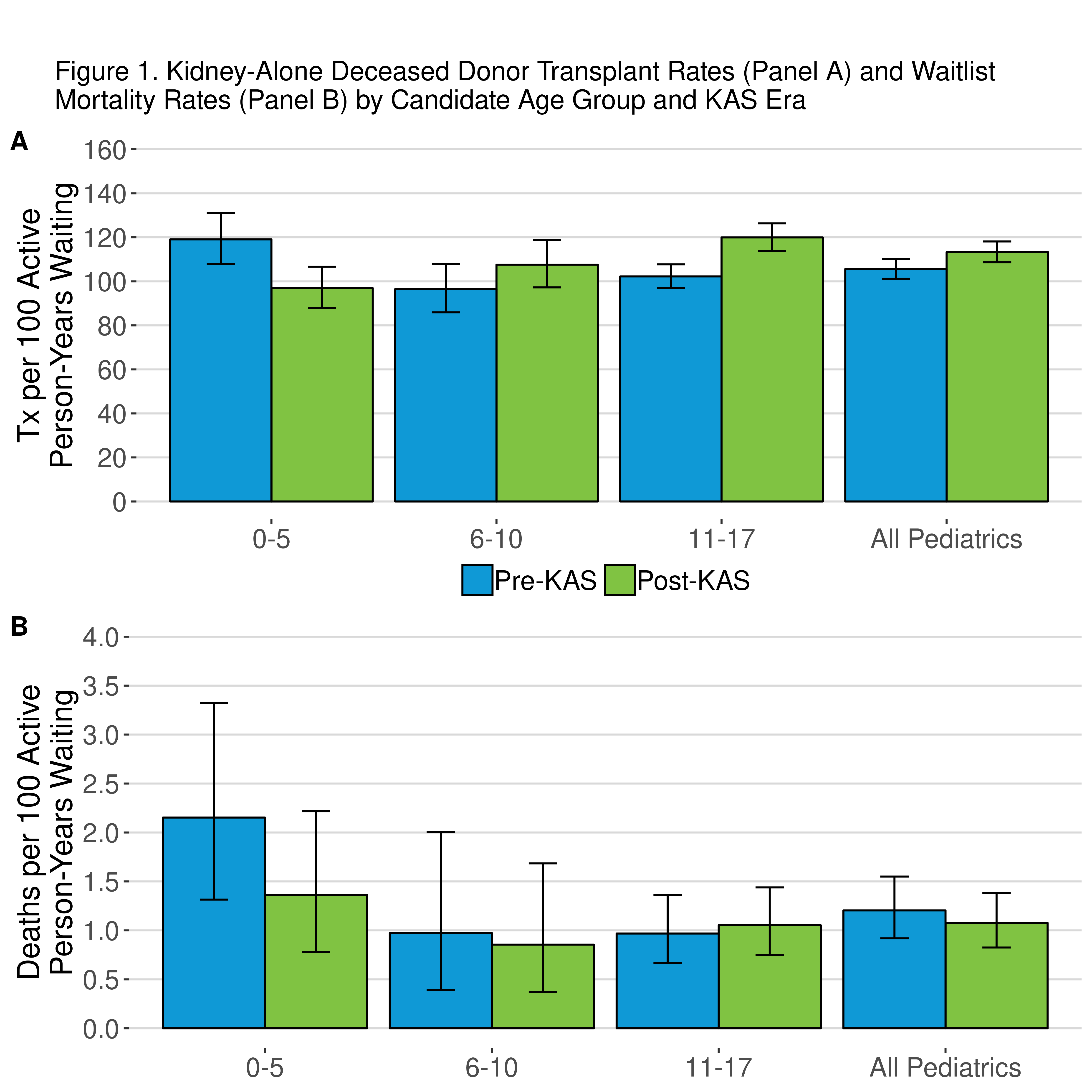Four Years of KAS: A Pediatric Specific Report
1United Network for Organ Sharing, Richmond, VA, 2Seattle Children's Hospital, Seattle, WA, 3Boston Children's Hospital, Boston, MA, 4Children's Hospital of Pittsburgh of UPMC, Pittsburgh, PA, 5University of Wisconsin Hospital and Clinics, Madison, WI
Meeting: 2020 American Transplant Congress
Abstract number: B-057
Keywords: Allocation, Kidney, Mortality, Pediatric
Session Information
Session Name: Poster Session B: Kidney: Pediatrics
Session Type: Poster Session
Date: Saturday, May 30, 2020
Session Time: 3:15pm-4:00pm
 Presentation Time: 3:30pm-4:00pm
Presentation Time: 3:30pm-4:00pm
Location: Virtual
*Purpose: On 12/4/14, the Organ Procurement and Transplantation Network (OPTN) implemented a new Kidney Allocation System (KAS). To maintain pediatric priority, KAS gave pediatric candidates priority for kidneys with a Kidney Donor Profile Index (KDPI) less than 35, whereas previously pediatric candidates received priority for kidneys from donors less than 35 years of age. With 4 years of post-KAS data available, this study examines the impact on pediatric kidney candidates/recipients at a deeper level than has been done previously.
*Methods: This study used data from the OPTN; multi-organ listings and transplants were excluded. Deceased donor transplant, waitlist mortality, and DR mismatch (MM) rates were assessed pre- (12/4/2010-12/3/2014) and post-KAS (12/4/2014-12/3/2018) for pediatrics overall and by age group (0-5, 6-10, 11-17). The KDPI distribution of pediatric kidney donors by age group was assessed post-KAS.
*Results: Deceased donor transplant rates for the 0-5 year old candidates significantly decreased post-KAS to 96.9 (95% Confidence Interval (CI): 87.9, 106.7) from 119.1 (CI: 107.9, 131.1) pre-KAS; the 11-17 year old age group saw a significant increase to 120.0 (CI: 113.8, 126.4) post-KAS vs. 102.3 (CI: 97.0, 107.7) pre-KAS (Figure 1A). Waitlist mortality rates decreased post-KAS vs. pre-KAS for all but the 11-17 age group, where they remained similar (Figure 1B). DR MM rates for 6-10 year old age group significantly increased post-KAS vs. pre-KAS (93.5% vs. 89.2%, p = 0.048), and remained similar for the 0-5 (93.7% vs. 93.4%, p = 0.862) and 11-17 year old age groups (92.1% vs. 91.2%, p = 0.456). Less than 1% of 0-5 year old donors, 32.3% of 6-10 year old donors, and 90.5% of 11-17 year old donors had a KDPI less than 35 post-KAS. Post-KAS, children received 8.3% of all pediatric deceased donor kidneys vs. 11.3% pre-KAS.
*Conclusions: Pediatric recipients are currently not prioritized for KDPI 35-100% kidneys, while many pediatric deceased donors have a KDPI greater than 35. Future changes to kidney allocation policy should continue to consider the impact to pediatric candidates.
To cite this abstract in AMA style:
Foutz J, Smith J, Wilk A, Vakili K, Mazariegos G, Bartosh S. Four Years of KAS: A Pediatric Specific Report [abstract]. Am J Transplant. 2020; 20 (suppl 3). https://atcmeetingabstracts.com/abstract/four-years-of-kas-a-pediatric-specific-report/. Accessed December 15, 2025.« Back to 2020 American Transplant Congress

